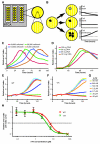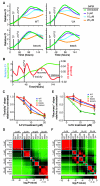Phenotypic profiling of DPYD variations relevant to 5-fluorouracil sensitivity using real-time cellular analysis and in vitro measurement of enzyme activity
- PMID: 23328581
- PMCID: PMC3602211
- DOI: 10.1158/0008-5472.CAN-12-3858
Phenotypic profiling of DPYD variations relevant to 5-fluorouracil sensitivity using real-time cellular analysis and in vitro measurement of enzyme activity
Abstract
In the 45 years since its development, the pyrimidine analog 5-fluorouracil (5-FU) has become an integral component of many cancer treatments, most notably for the management of colorectal cancer. An appreciable fraction of patients who receive 5-FU suffer severe adverse toxicities, which in extreme cases may result in death. Dihydropyrimidine dehydrogenase (DPD, encoded by DPYD) rapidly degrades 85% of administered 5-FU, and as such, limits the amount of drug available for conversion into active metabolites. Clinical studies have suggested that genetic variations in DPYD increase the risk for 5-FU toxicity, however, there is not a clear consensus about which variations are relevant predictors. In the present study, DPYD variants were expressed in mammalian cells, and the enzymatic activity of expressed protein was determined relative to wild-type (WT). Relative sensitivity to 5-FU for cells expressing DPYD variations was also measured. The DPYD*2A variant (exon 14 deletion caused by IVS14+1G>A) was confirmed to be catalytically inactive. Compared with WT, two variants, S534N and C29R, showed significantly higher enzymatic activity. Cells expressing S534N were more resistant to 5-FU-mediated toxicity compared with cells expressing WT DPYD. These findings support the hypothesis that selected DPYD alleles are protective against severe 5-FU toxicity, and, as a consequence, may decrease the effectiveness of 5-FU an antitumor drug in carriers. In addition, this study shows a method that may be useful for phenotyping other genetic variations in pharmacologically relevant pathways.
Figures





Similar articles
-
Functional Characterization of 21 Allelic Variants of Dihydropyrimidine Dehydrogenase Identified in 1070 Japanese Individuals.Drug Metab Dispos. 2018 Aug;46(8):1083-1090. doi: 10.1124/dmd.118.081737. Epub 2018 May 16. Drug Metab Dispos. 2018. PMID: 29769267
-
Absence of large intragenic rearrangements in the DPYD gene in a large cohort of colorectal cancer patients treated with 5-FU-based chemotherapy.Br J Clin Pharmacol. 2010 Aug;70(2):268-72. doi: 10.1111/j.1365-2125.2010.03683.x. Br J Clin Pharmacol. 2010. PMID: 20653680 Free PMC article.
-
Clinical implications of dihydropyrimidine dehydrogenase (DPD) activity in 5-FU-based chemotherapy: mutations in the DPD gene, and DPD inhibitory fluoropyrimidines.Int J Clin Oncol. 2003 Jun;8(3):132-8. doi: 10.1007/s10147-003-0330-z. Int J Clin Oncol. 2003. PMID: 12851836 Review.
-
DPYD genotype-guided dose individualisation of fluoropyrimidine therapy in patients with cancer: a prospective safety analysis.Lancet Oncol. 2018 Nov;19(11):1459-1467. doi: 10.1016/S1470-2045(18)30686-7. Epub 2018 Oct 19. Lancet Oncol. 2018. PMID: 30348537
-
Prospective DPYD genotyping to reduce the risk of fluoropyrimidine-induced severe toxicity: Ready for prime time.Eur J Cancer. 2016 Feb;54:40-48. doi: 10.1016/j.ejca.2015.11.008. Epub 2015 Dec 21. Eur J Cancer. 2016. PMID: 26716401 Review.
Cited by
-
Clinical Implementation of Rare and Novel DPYD Variants for Personalizing Fluoropyrimidine Treatment: Challenges and Opportunities.Int J Biol Sci. 2024 Jul 2;20(10):3742-3759. doi: 10.7150/ijbs.97686. eCollection 2024. Int J Biol Sci. 2024. PMID: 39113696 Free PMC article. Review.
-
Population-scale predictions of DPD and TPMT phenotypes using a quantitative pharmacogene-specific ensemble classifier.Br J Cancer. 2020 Dec;123(12):1782-1789. doi: 10.1038/s41416-020-01084-0. Epub 2020 Sep 25. Br J Cancer. 2020. PMID: 32973300 Free PMC article.
-
Rare Dihydropyrimidine Dehydrogenase Variants and Toxicity by Floropyrimidines: A Case Report.Front Oncol. 2019 Mar 11;9:139. doi: 10.3389/fonc.2019.00139. eCollection 2019. Front Oncol. 2019. PMID: 30915274 Free PMC article.
-
Importance of Rare DPYD Genetic Polymorphisms for 5-Fluorouracil Therapy in the Japanese Population.Front Pharmacol. 2022 Jun 15;13:930470. doi: 10.3389/fphar.2022.930470. eCollection 2022. Front Pharmacol. 2022. PMID: 35784703 Free PMC article.
-
HDAC-driven mechanisms in anticancer resistance: epigenetics and beyond.Cancer Drug Resist. 2024 Nov 20;7:46. doi: 10.20517/cdr.2024.103. eCollection 2024. Cancer Drug Resist. 2024. PMID: 39624079 Free PMC article. Review.
References
-
- Rich TA, Shepard RC, Mosley ST. Four decades of continuing innovation with fluorouracil: current and future approaches to fluorouracil chemoradiation therapy. Journal of clinical oncology: official journal of the American Society of Clinical Oncology. 2004;22:2214–32. - PubMed
-
- MacMillan WE, Wolberg WH, Welling PG. Pharmacokinetics of fluorouracil in humans. Cancer Res. 1978;38:3479–82. - PubMed
-
- Heggie GD, Sommadossi JP, Cross DS, Huster WJ, Diasio RB. Clinical pharmacokinetics of 5-fluorouracil and its metabolites in plasma, urine, and bile. Cancer Res. 1987;47:2203–6. - PubMed
-
- Longley DB, Harkin DP, Johnston PG. 5-fluorouracil: mechanisms of action and clinical strategies. Nat Rev Cancer. 2003;3:330–8. - PubMed
-
- Harris BE, Song R, Soong SJ, Diasio RB. Relationship between dihydropyrimidine dehydrogenase activity and plasma 5-fluorouracil levels with evidence for circadian variation of enzyme activity and plasma drug levels in cancer patients receiving 5-fluorouracil by protracted continuous infusion. Cancer Res. 1990;50:197–201. - PubMed
Publication types
MeSH terms
Substances
Grants and funding
LinkOut - more resources
Full Text Sources
Other Literature Sources
Molecular Biology Databases

